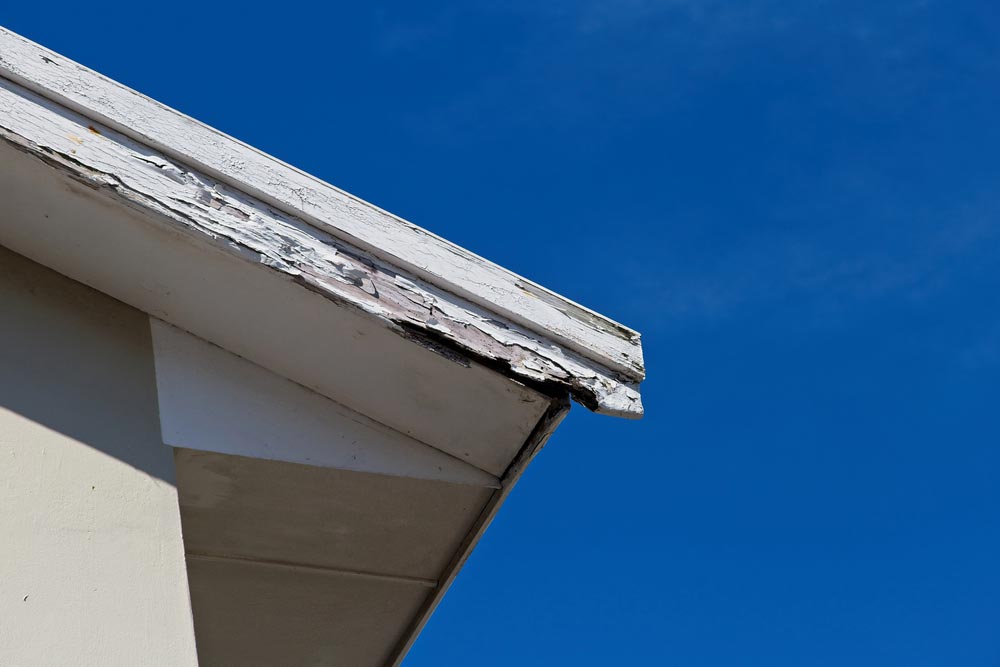The roof is one of the most important parts of your home, because it protects you and your possessions from what’s going on outside. If you have problems with your roof, the results can be devastating (especially if a storm moves through your neighborhood). But there are other parts of your roofing system (such as fascias and soffits) with which you may not be familiar. Many homeowners don’t know about or understand some of the peripheral elements that are part of their roof, but they play an important role in protecting your roof so it can keep protecting you.

Fascia Needs Repair
Why Fascias Are Important
The fascia is a series of flat boards that are perpendicular to the roof, and its purpose is to finish off the edges. It’s also where your gutters will be installed (if you have them). Fascias will affect your home’s curb appeal, so you want to keep them in good shape. It’s also a good reason to choose a material that’s easy to maintain, so you don’t have to worry about them as often.
Aside from protecting the ends of your rafters, your home’s fascia protects the last line of shingles on your roof. Without it, the shingles could bend and even come off during strong winds. They also provide a sturdy anchor point for mounting your gutters, so you want to do your best to keep them clean. It will keep water from pooling along the fascia, which can lead to rot and mold if it’s left too long.
Your fascia will have a thin sheet of material that’s added to the outside of the board, so it can have some extra protection from the elements. This is called the “fascia trim” (sometimes referred to as the “fascia cover,” fascia cap,” or “fascia board flashing”). It can be made from a variety of materials, but some of the common ones include:
- Vinyl
- Aluminum
- Copper
You generally want to choose a material that matches your gutter system.
Types of Fascia Materials
Fascia boards are usually long, thin pieces of wood (which can be anything from spruce to cedar). But it can also be made out of composite wood products, which are more resistant to water and moisture. You can even find fascia boards that are made out of a variety of plastics (including UPVC and PVC), which are even more impervious to water and moisture. They’re also more resistant to temperature fluctuations, because they’re less likely to swell and shrink with hot-cold cycles. From the ground, these plastic boards will look similar to wood. Most of them can be painted to match your gutters.

New Fascia & Soffit
When to Repair or Replace Your Roof Fascia
Because they’re so close to the roof line, your fascia boards can get damaged over time. When that happens, you need to repair or replace them as soon as possible. If the fascia is only slightly damaged, you might be able to repair it with a sealant or caulk. But if the damage is more severe, you’ll have to replace it entirely. In most cases, you’ll need to remove the gutters to work on the fascia. You should also be careful while you’re working on the roofline, because it can be dangerous. If you’re not comfortable doing the work yourself, you should contact a professional for help.
Here are some of the signs that your roof fascia needs to be replaced:
- Moisture Damage — Your fascia might get this kind of damage if the boards were left unsealed or without any trim. Roof leaks, gutter clogs, and other roofing problems can also cause the fascia to become consistently exposed to moisture (which can eventually lead to rot).
- Mold, Fungus, or Algae — Severe mold and fungus infections on the top of your roof can spread down to your fascia, and the same is true for black algae stains.
- Cracks — This type of damage could be the result of temperature changes, water damage, or age. But regardless of the cause, the boards will need to be replaced.
- Animal Damage — Animals are often determined to get into your attic for shelter, so they may chew on your fascia boards or make tiny gaps between them and the roof.
- Bowing — A bent or bowed fascia board may be indicative of some kind of structural problem with your home. So if you see this type of damage, you will have to discuss it with your roofing team.
- Holes — Any hole in your roof fascia (even a nail hole) can be large enough to allow water to get inside your attic. Small holes can be filled or sealed. But if they’re larger, you may need to replace the fascia board.
If you need fascia repair and are looking for one of the best roofers in Corpus Christi, be sure to get in touch with Bayfront Roofing.